
Epistylis is a disease commonly confused with ich. It can look almost identical to ich. Epistylis is typically fuzzy and translucent while ich is clearly defined and very white. Epistylis stick out from the fish while ich only slightly protrudes from the fish. Epistylis is commonly found secondary to a bacterial infection. I recommend treating epistylis with:
- Feed an antibiotic like Kanaplex or Maracyn 2 in the food and ONLY in the food.
- Dropping the aquarium temperature to 70 degrees
- Add a ton of aeration to the aquarium
- Feed the antibiotic laced food very lightly till the infestation clears
- If there is any possibility that it is ich or a mixed ich/epistylis infection add a formaldehyde/ malachite green medication like Ich-X to the water
Epistylis is commonly confused with ich. Here is a list to prevent confusion between ich and epistylis:
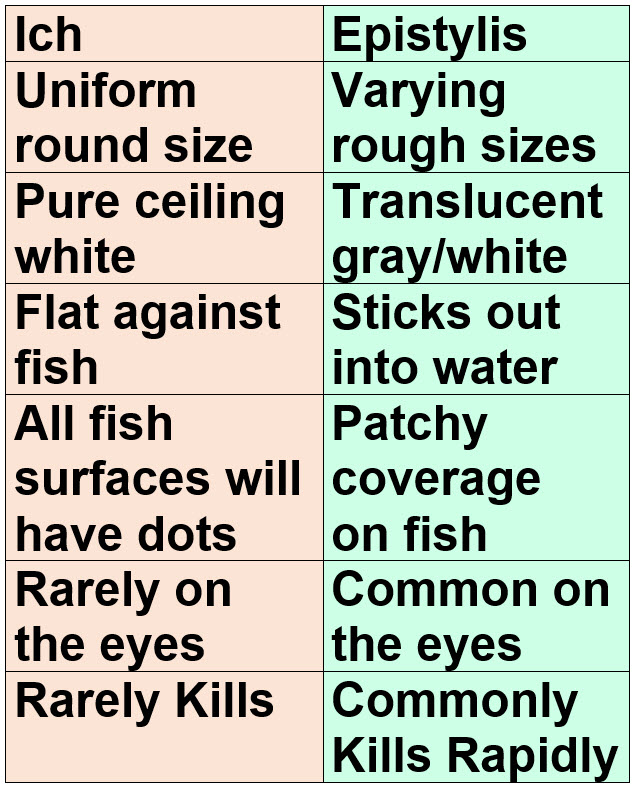
The following is an actual comment on a Facebook forum:
“I’m devastated. I bought 6 cardinal tetras from Petco and stupidly didn’t quarantine before adding them to my 55 gal planted community tank. I have now lost 30 fish to ICH. 😭 I had a large school of neons, 6 guppies and a sorority of female Bettas. All gone save for 1 Betta and 2 Otto’s, but I fear they will soon die too. 😭 I’m treating the tank with the Kordon Ich attack and heat, but I fear I caught it too late. 😭“
This is a photo they provided:

This unfortunate person’s fish did NOT die from ich. They died from a bacterial infection with secondary epistylis. The white spots are irregular in size, on the eyes, stick out into the water, and the fish are all rapidly dying in an established aquarium. All of these are the hallmarks of bacterial infection (probably columnaris) with a secondary epistylis infection.
The bacteria attack the fish both internally and externally. It is the internal bacterial infection which will kill the fish. The external bacterial infection sheds bacteria which feed the epistylis. Killing the external bacteria will not save the fish from the lethal effects of the internal infection.
What follows is a very lengthy and boring paper on epistylis. Read on only if you are a real aquarium nerd like the author.
Epistylis in Depth
Epistylis is a very common opportunistic organism found in small quantities in most aquariums and on many fish (Diana Walstad researched it and found it was found on most fish by pathologists). It is a single celled ciliated protozoan closely related to paramecium and tetrahymena. A single epistylis is too small to be seen by the naked eye but epistylis grows in branching, stalked colonies which can become relatively large, up to three times the diameter of an ich spot.
Epistylis is an opportunistic organism which feeds on bacteria in the water column and generally, but not always, simply uses the fish as something to hold onto. Sometimes, if an aquarium is heavily overfed, the bacteria in the water column becomes so numerous that it feeds epistylis on the glass of the tank. Little white dots of epistylis colonies will appear in patches on the aquarium glass.

Sometimes the epistylis on a fish exists in a symbiotic relationship with a gram negative bacteria. The bacteria and the epistylis attack the skin of the fish in concert. It is often unclear whether the primary attacker is the bacteria or the epistylis but it is unimportant. What is important is that virtually all epistylis infections should have antibiotics put in the food to kill the bacteria.
The size of individual colonies of epistylis is quite variable. The organism itself is much smaller than the ich organism. So epistylis can appear like a light dusting on a fish. Well intentioned but ill-informed commentators on the social media often identify this as “velvet”. It isn’t. It is something called “small colony epistylis”. It is very difficult to differentiate this from costia and chilodonella. Note “velvet” has distinct golden color so it is easily differentiated from epistylis.

.

Epistylis and Ich
Whenever a good photo of any fish disease comes up on social media we make a screen capture of it for reference. We number these screen captures. We have 97 screen captures of what is clearly epistylis and 49 screen captures of what is clearly ich. So epistylis appears to be more common in home aquariums than ich. Note we also have about 35 photos which could be epistylis or could be ich. The only way to tell for sure is to take a scraping and examine it under a microscope. This is why we recommend any questionable diagnosis be treated for BOTH ich and epistylis.
The photo below is a fish with ich. Note how ich is a very well defined, very white spot which does not stick out much from the fish. Ich is the size of a grain of salt, no larger and no smaller.
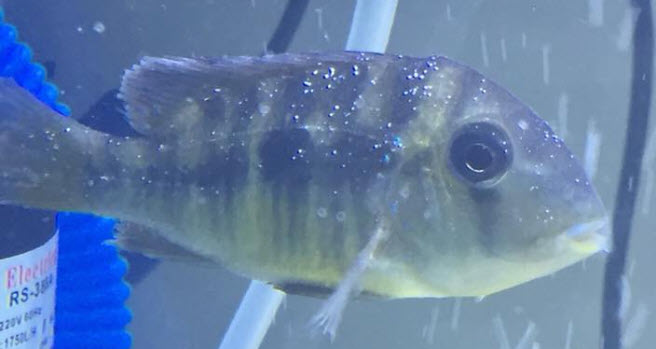
The appearance of epistylis on loaches is virtually identical to the appearance of ich and is the source of a lot of confusion. If a hobbyist has loaches, goldfish or other bottom dwellers who have a persistent case of “ich”, treat the fish with antibiotic laced food. It won’t hurt them and you might save the fish.
Here is a photo of a loach with epistylis. Note how much it looks like ich.


Note the growths on the eyes of this fish. Ich only rarely appears on the eyes of the fish and is a very white round dot when it does appear on the eye:
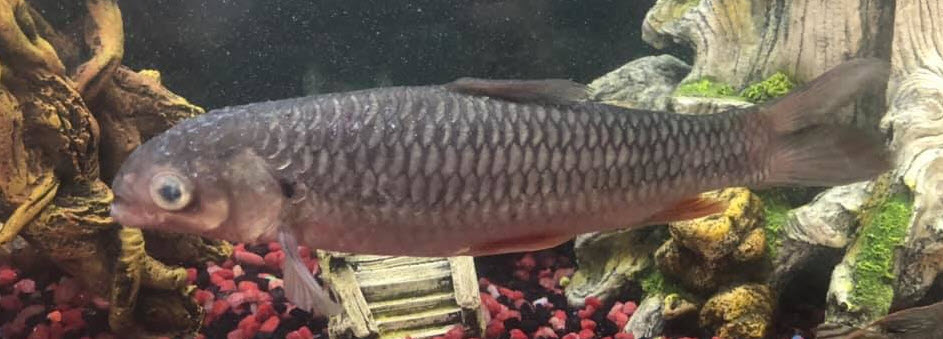
Symptoms
Epistylis is small to large gray or white spots on the fish. Whenever a post with a picture of a fish with epistylis posts on social media there is an avalanche of posts identifying the culprit as ich. Ich and epistylis are easy to get confused. Here are some examples of epistylis that could be mislabeled ich very easily:
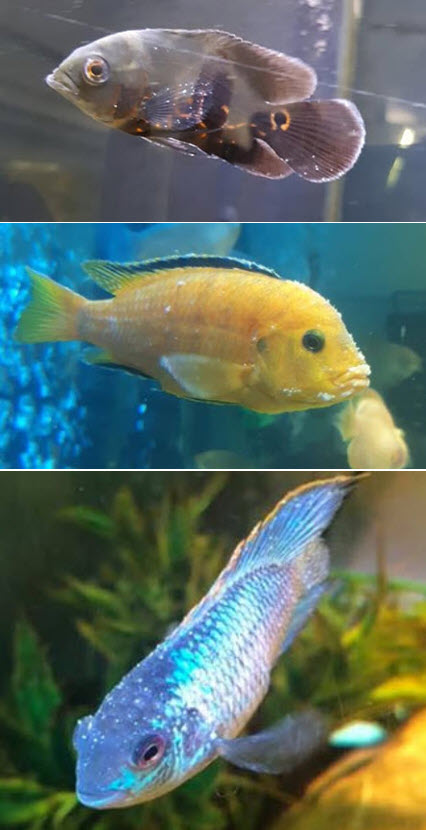
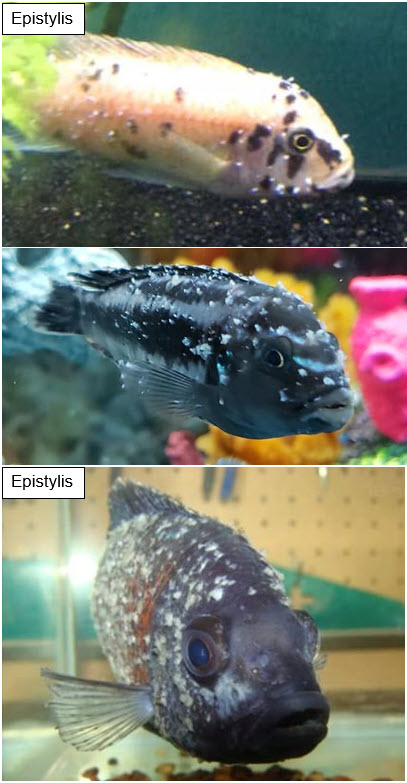
Epistylis seems to attack loaches, goldfish and bottom dwellers preferentially, especially in tanks with little water circulation and/or poor aeration. This may be due to a higher bacteria concentration near the substrate, especially if there is a bottom mulm present. When loaches get epistylis always look hard at the aeration and water circulation in the aquarium.
Adding two small wavemakers is always a good option for larger aquariums. Add one at the back of one side aimed at the surface so as to give lots of “choppy waves”. A large area of “choppy waves” is probably the best way to add aeration, with lots of bubbles from a decent sized air pump and air stones being a close second. Add the other wavemaker to the bottom middle of the other side of the aquarium aimed at the substrate at the front of the aquarium to clear any mulm present. This sets up very good circular current in the aquarium.
Goldfish seem to be especially prone to bacterial infections followed by epistylis. Here are some goldfish with bacterial/epistylis infections:

Here is a goldfish with both hemorrhagic septicemia and epistylis:

This is another fish with both epistylis and hemorrhagic septicemia (“red blotch disease”)
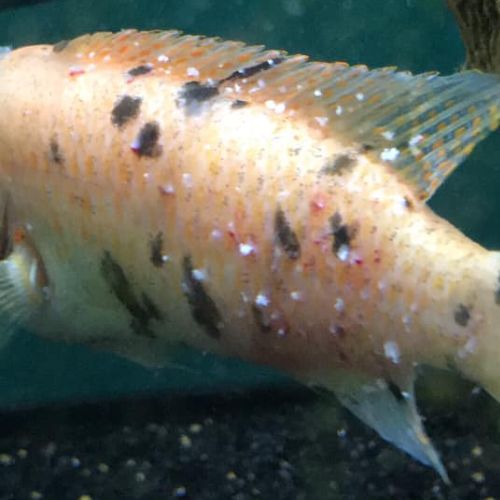
Epistylis often occurs in fish with fin rot. The bacteria (generally columnaris) infecting the fins are feeding the epistylis. Many think the “white spot” on the fins are causing the erosion of the fins. It is actually the other way around. The erosion of the fins is causing the white spots. Here are two goldfish with fin rot which also have epistylis (note the spots on the eyes).

Causes of Epistylis
There are several causes of epistylis:
- The water has a high bacteria count in it because of poor filtration, over feeding and/or poor aeration in the aquarium.
- Bacteria are invading the fish, either as a generalized infection with no symptoms, hemorrhagic septicemia (“red spot”, generally aeromonas), slime coat syndrome or as fin rot (generally columnaris).
- The aquarium has a bacteria rich mulm just above the substrate caused by poor aeration and poor water circulation.
- The aquarium has a large substrate such as pea gravel where food is trapped in the substrate. This rotting food will cause huge bacterial problems with bottom dwelling fish like loaches, which in turn causes big problems with epistylis.
- If the water has a high bacteria count and the epistylis gets a foothold on a fish, then the epistylis secrets an enzyme at its base which attacks the slime coat of the fish. This attack allows bacteria into the body of the fish, creating hemorrhagic septicemia which further feeds the epistylis. This sets up a vicious cycle which can kill the fish.
Epistylis is typically an outward sign of a serious bacterial infection. Fish with epistylis commonly die very rapidly, not from the epistylis, but rather from an internal bacterial infection.
Hobbyists seem to have difficulty with the idea of two pathogen being on a fish at once. A very common combination seen in fish is when a bacteria attacks the skin of the fish, causing “slime coat syndrome”. Then secondary epistylis attaches to the fish and begins to feed on the bacteria being shed by the skin infection. The following fish has slime coat syndrome with secondary epistylis.

But epistylis CAN occur without an underlying bacterial infection. The following photo is instructive. This is a molly (a livebearer!) with a clear case of epistylis. The fish had survived six days when this photo was taken. This does NOT seem to be a bacterial infection of the fish with secondary epistylis. Rather the water is cloudy and the water surface is a solid mat of bubbles. This would indicate a high bacteria count in the water and the epistylis is merely feeding off the bacteria in the water. The only thing that will help this fish is to add a ton of biofiltration.

Mortality Between Ich and Epistylis
The combination of bacteria with secondary epistylis kills fish relatively rapidly and frequently. Ich rarely kills tropical fish.
A survey was done on ich. The members of about ten Facebook aquarium groups were asked: “Of the cases of ich that YOU have had in YOUR aquariums, how many fish died?”. There were about 70 replies. Three of the replies had fish which died. All these three instances were where new fish were added to an aquarium. All the rest of the replies had no fish deaths, including one keeper with 200 aquariums for 30 years and one who had many aquariums for fifty years. This is very revealing. Ich is just rarely fatal in the home aquarium.
So if one has an aquarium where fish are dying left and right from what appears to be ich it is often not ich, but rather “columnaris” (more properly called a bacterial infection) combined with epistylis. The “columnaris” typically has no symptoms at all (it could well be any one of dozens of bacteria, columnaris being only one). The distinction is important, especially as ich is often treated with higher water temperatures (incorrectly I might add, research says higher temperatures are not effective in treating ich). Columnaris bacteria and epistylis thrive at higher temperatures so using high temperature to kill what appears to be ich only insures the fish die.

I’m not big on anecdotal evidence but a comment from Facebook is pertinent here:
Tiffany Peterson “My rasboras had what I thought was ich, except I treated with Ich-X and daily water changes literally the very same day symptoms showed and after four days of no change, they started dying… I ended up treating for ich for 10 days total with no benefit, lost half of my school, nine fish. Eventually a fish store diagnosed it as epistylis, said there’s no way ich would act that way (the white dots never ‘fell off’ like ich is supposed to) and not respond to ich meds. Literally the first day I used the erythromycin the fish looked better. The survivors had gotten to the point where they were basically transparent from stress except for the white dots, they wouldn’t swim or eat…just hovering in place. One course of antibiotics, much better and back to perfectly normal after two courses (four doses). Did a third for good measure and started feeding antibiotic flakes at that point too.”
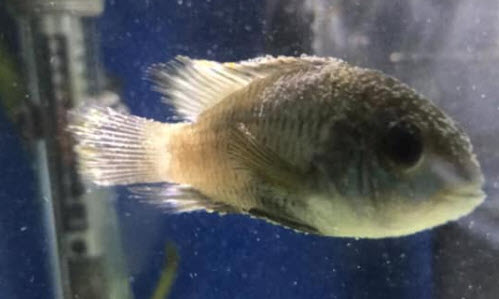
Treatment
Most epistylis cases can either be ich or be epistylis. The two are so similar that often the “white spots” could be either disease. So I recommend treating with a formalin/malachite green medication like Ich X in the water AND antibiotics like Kanaplex or Maracyn 2 in the food.
Epistylis occurs very frequently in newly set up aquariums with “dull” water and inadequate filtration, poor water circulation, over-feeding and poor aeration. Very often the best treatment for epistylis is to considerably reduce or even stop feeding for a while, add some very good filtration, add some wavemakers to circulate the water and add a ton of aeration. Proper food levels (the volume of two eyeballs once per day MAXIMUM of pellets, six fish = twelve eyeballs), over-filtration, over aeration, good water circulation and crystal clear water should be the goal of all hobbyists in order to have healthy fish.

Any aquarium with epistylis should be thoroughly cleaned of all mulm and detritus in the aquarium. The filter (including undergravel filters) should NOT be cleaned. Filters filled with brown detritus have millions of tiny organisms in them that literally “eat” bacteria in the water column. Thus a filter filled with brown mulm will hugely reduce the number of free floating bacteria feeding the epistylis.
I do not like cartridge hang on back or cartridge internal filters. Epistylis is very commonly associated with these cartridge filters. If one has a cartridge filter improve it by adding the sponge or pot scrubbers recommended in this link:
8.2. Hang on Back Filters
And several 95% water changes are in order over the span of a few days. Note 95% water changes do not harm the fish, contrary to popular mythology. Also note that antibiotics in the water column will only kill bacteria in the water column for a few hours. Then the antibiotic actually feeds a bacterial bloom. And note epistylis eat dead bacteria just as avidly as live bacteria.

Note I have noticed some newcomers to the hobby who just don’t seem to understand what good water aeration and water circulation are. They come on social media with a picture of several sick fish hanging near the surface of some water whose surface is dead still, with no “choppy waves” and only a few bubbles coming from an undersized air pump working a tiny cartridge internal filter. When told they need better water circulation, better biofiltration and better aeration the typical response is “But I have lots of bubbles and a filter“.
For small aquariums I like the Sunsun HW-603B External Canister Filter ($40). It has 80 cubic inches foam which makes a great biological filter if you only very lightly clean it once every four to eight months (ignore the profit minded directions which say to replace the foam). Also I like under gravel filters. If you clean under-gravel frequently, they are a pain in the butt and do not work well. If you just leave them alone, they are a great inexpensive filter. If you use a sponge or an under-gravel power them with a powerhead rather than bubbles and you will triple the filtration capacity.
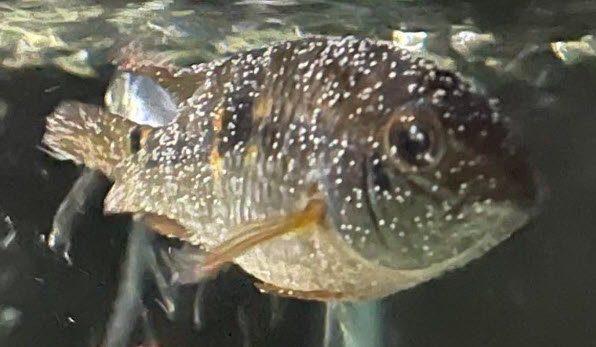
A little anecdotal evidence might be somewhat useful here. This is a comment from Brian:
“Last November, I was treating my tank for ick and desperately trying to save my fish based on internet postings that all contained conflicting information. After losing all 5 of my 8 yr old clown loaches, I stumbled across your website that made it clear I didn’t have ick but had epistylis and me and my tank conditions were to blame.
I replaced the media in my filters with foam, changed out my substrate from pea gravel to a finer gravel, stopped my occasional vacuuming of the gravel, stopped feeding my fish so much, and quit cleaning my filters. These changes have drastically cut down on my maintenance and completely transformed my tank into a beautiful centerpiece with crystal clear water, healthy plants, and healthy fish.”
Brian had epistylis because of the conditions in his tank. When he corrected the conditions things improved immensely.

Medication for Epistylis
Epistylis does not feed on the fish. It feeds on the bacteria in the skin mucus of the fish and in the water column. Epistylis is commonly accompanied by pathogenic gram-negative bacteria either as fin rot, slime coat disease or septicemia. The generalized symptomless bacterial infection, fin rot (typically columnaris bacteria) or hemorrhagic septicemia (small red areas of blood beneath the skin that are caused by aeromonas bacteria) are typically the organisms which kill the fish, not the epistylis. So it is important to treat the fish with a broad spectrum antibiotic IN THE FOOD AND ONLY IN THE FOOD.
Bacterial diseases need to be hit with a broad-spectrum antibiotic. These need to be obtained from the internet. They include Thomas Labs Fish Mox, Midland Vet Service Aqua-Mox, VetDepot Amoxicillin, SeaChem KanaPlex, Fishbiotic Ampicillin, Mardel Maracyn 2, Thomas Labs Fish Min and Thomas Labs Fish Doxy. They are ONLY effective when mixed with the food (contrary to manufacturers profit driven instructions).
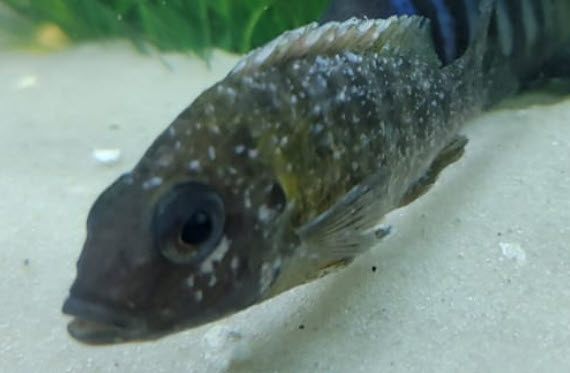
It is easy to make medicated food. Heat 1/4 cup water (two ounces or 58 milliliters, not a lot) in the microwave. Then blend seven grams of plain animal derived gelatin (Knox gelatin, one packet) into the hot solution with vigorous stirring. Take two tablespoons of dry commercial fish food (pellets or flake) and mix it with just a little of the hot water/ gelatin mixture. Add hot water/gelatin until you get a paste like consistency. If it gets too watery just add more food. To get gel food to float simply mix in a little whipped cream at this point.
Then add just a “smidgen” (roughly 1/16 teaspoon, a 1% to 2% addition) of medication to the mud. If you are using a packet of medication, take just a “smidgen” of the packet contents. Mix and mash the whole mass thoroughly. Mix and mash the whole mass thoroughly. Spread it out into a pancake about 1/8th inch (3 mm) thick on a plastic film or a plate. Then put in the refrigerator. If you plan on keeping it for more than two weeks put it in a small plastic bag and freeze.
Feed this medicated food and only this medicated food to all the fish in the aquarium for at least ten days. If it hasn’t resolved itself, try another antibiotic which is effective against gram positive bacteria.

Treating Epistylis Directly
Epistylis is distantly related to ich and, according to the literature, is susceptible to copper or formalin/malachite green just like ich. But note the author’s experience says that epistylis does not readily respond to ich medications.
But if fish have white spots which might be ich or might be epistylis (a very common occurrence!), it will not hurt the fish to put a formalin/malachite green ich medication like Ich X in the water and to feed the fish medicated food. Probably 50% of the cases of “white spots” should be treated as though both ich and epistylis are present.
There is research which says a 1.5 to 2% salt bath (3.5% is the salt concentration of the ocean), repeated every 24 hours is effective.
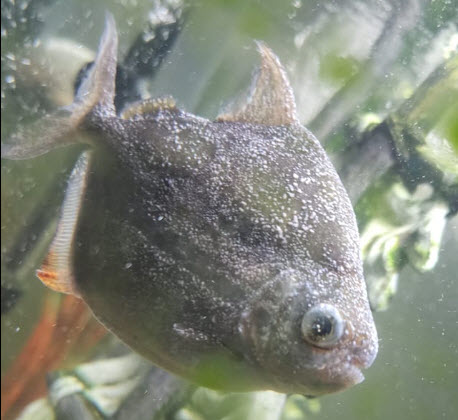
“Use of Common Salt (NaCl) in the Control of Epistylis sp. in Hybrid Sorubim”. Rodrigues et. al. 2019
“The treatments consisted of three therapeutic baths performed every 48 hours for 20 minutes with different concentrations of common salt: 0.0%, 1.0%, 1.5% and 2.0%. The experiment lasted six days. Twenty-four hours after the last bath, the fish were sampled to check for the presence of the parasite and blood collection. Salt treatments of 1.5% and 2.0% were effective in eliminating parasites in 82% and 78% of treated fish, respectively. Fish subjected to the 2.0% salt bath showed higher hematocrit and hemoglobin values (P <0.05) compared to fish in the control group, in addition to changes in leukocyte values. Common salt can be used to control Epistylis sp. in naturally infected surubim juveniles.”
Put the fish in a 1.5 to 2% salt bath for up to twenty minutes. Watch the fish carefully. Different fish have much different tolerances for salt at this level. When the fish loses equilibrium and rolls over, quickly return them to fresh water.
A liter of water is 1,000 grams. There are 5.69 grams of salt in a level teaspoon of salt. So a 1.5% solution is about 3 level teaspoons of salt per liter of water. Or 10 level teaspoons (roughly one fourth cup) of salt per gallon of water in a tray.
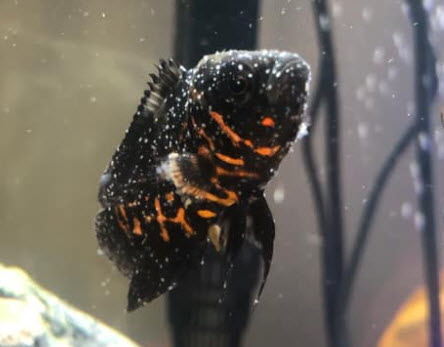
Treating Epistylis Indirectly with a “Mature” Filter
A “mature” filter full of brown gunk is a very good “treatment” for epistylis. The reasoning behind this is a somewhat lengthy cause and effect chain but the logic is sound, even if there is no research backing it.
The epistylis organism is present in almost all tanks feeding on bacteria in the water. When the bacteria count in the water gets high, such as when a new tank and new filter are set up, epistylis can proliferate and end up on the fish. Once on the fish it can become pathogenic and erode the protective coating on the fish’s skin. This allows pathogenic bacteria to enter the fish’s body and start septicemia. Alternatively the septicemia can come before the epistylis.

With an old uncleaned filter more than two months old or so, the filter is “mature” and has a good coating of brown “gunk” on it. This brown gunk will have a ton of epistylis organisms (and other organisms much like epistylis) in it eating the bacteria in the water. The epistylis in the filter will eat so much of the bacteria in the water column that there will be not bacteria for epistylis organisms on a fish to eat and reproduce. So epistylis will not appear on a fish.
This disease prevention by an established, mature filter is a very important feature in all aquariums. It is why the experts keep emphasizing how a mature aquarium is so much more healthy than a newly set up aquarium. This is why it is so important for newcomers not to take things too rapidly. Add small numbers of small juvenile fish to any new aquarium. Go slow! And do not clean or change the filter unless the slow flows down.

References:
E. L. Johnson, p 54:
“The parasite Epistylis gets far too little attention in the literature despite its relatively common appearance in our ornamental fish. The disease appears as whitish or off-white tufts of fluffy growth that spring up all over the affected fish… Most often the fins and eyes are affected, and the owner mistakes the pathogens for fungus (Saprolegnaceae) because fungus infections also appear as tufty whitish growths.”
Johnson then has a picture of the tufts. The tufts or colonies of epistylis are about 0.5 to 2 mm high and white. Here is one photo found of them at roughly 50 x magnification.

Per Noga p155-156:
“Epistylis is the most common and pathogenic type of sessile, colonial ectocommensal ciliate. It is commonly associated with a mixed infection of gram-negative bacteria known as red-sore disease (Esch et al. 1976). Like other ectocommensal protozoa these organisms feed on bacteria and other small food items present in the water. They use the fish as a surface for attaching. Thus, their presence is indicative of organically polluted water that would tend to have a high concentration of bacteria.”
Noga is correct on the “organically polluted water” comment. If one has water with a high bacterial count this organism can thrive since it is a ciliated filter feeder and water with a high bacterial count feeds the ciliated organisms. And the term “ectocommensal” means an organism that lives on the surface of another “host” organism without harming the host organism.
Note that there are some other closely related ciliated organisms which might occasionally be seen and present exactly the same way as epistylis. These include Apiosoma, Scopulata and Ambiphrya. They are for all intents and purposes identical to epistylis so making a distinction isn’t important.
White Tufts on the Forehead
There is a YouTube video where an individual shows a video of an angelfish in his aquarium . The angelfish has some white dots on the forehead. The YouTube video maker is identifying these as epistylis. This is not epistylis. This is a disease called “canal neuromast inflammation”. It is how hole in the head manifests itself, typically in small cichlids.
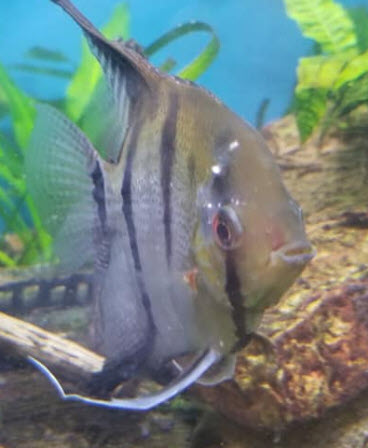
More details on this disease can be found on the following link:
11.1.2. Canal Neuromast Inflammation or White Spots on Forehead
.
Return to Diseases Menu
Return to Protozoan Menu
.
Aquarium Science Website
The chapters shown below or on the right side in maroon lead to close to 400 articles on all aspects of keeping a freshwater aquarium. These articles have NO links to profit making sites and are thus unbiased in their recommendations, unlike all the for-profit sites you will find with Google. Bookmark and browse!
.

Dave says
In reply to Amira ….. You are correct, medicated food is best.
Amira Zahra says
Feeding medicated food is better than to totally stop feeding the fish, right?
Gershom Lundberg says
I don’t know how to attach the pictures, but will try to find out.
Gersh Lundberg says
David—
I saw white spots on some of my new juvenile cichlids (1-1.5 inch festae or red terrors). After reading 10.2.4 it seems like they probably have epistylis, and for 5 days I have been treating with rigorous cleaning and water changes, homemade food with metronidazole, and 1.5% salt dips for 15 to 20 minutes. No definite improvement.
1. What about using salt in the tank (2 tsp/gallon) in addition to salt dips?
2. Why does medication in the water “feed a bacterial bloom” after a few hours?
3. Are juveniles more susceptible to injury by salt osmotic pressure than adults, due to small size?
4. Will diatomaceous earth filtration be effective at removing bacteria (ie, instead of 95% water changes?)
5. The pictures are poor, but can you tell about ich vs epistylis?
6. Is Flagyl the wrong antibiotic?
Thank you for any help!
Christine says
Your article was incredibly helpful, thank you so much. Our tank was just hit with Epistylis I believe. Like many, at first I thought it was Ich, but they were all dying too fast. Including our Betta, Spike. We were devestated. He was in a tank with tetras, who were dying off one by one… We only have one now, and not a lot of hope.
Can you please tell me what to do after the inevitable passing of our last tetra? Do we wash everything in a bleach mixture and start over? I’m terrified to re-use anything we had and have already gotten rid of all our live plants.
Kelly says
Dave, thank you for responding.
My pleco and one black Molly are still alive but in rough shape.
Pleco is wasting, not eating and often, when not hiding, stuck to the top of the glass with his head half out of the water.
*I am unfamiliar with the bath method or the pipette method.*
I purchased Ron’s Cichlids Medicated Food Mix, and Stress Guard.
Re-treated with API SUPER ICK CURE – good quality, close-up photos of the black Molly show very white spots looking very much like Ich, but I’m definitely convinced of multiple issues as well as how difficult diagnosing is – he/she rests on the bottom but actively swims and eats, clamped fins.
Nitrates still very high – bright red – and I’m confused, only two fish in 54g, frequent water changes (after treatment as directed), little to no food being added, all debris skimmed out with net..
Could it be the plants that are unhappy, ragged/decaying?
Nitrite 0
Ammonia maybe a hint, but doubt it, very yellow, not green.
Our water pH is high, 8+ ish – slight purple tint.
I have many photos and video if they will be of use to anyone, now or in future.
(Not sure how I missed your response, I kept checking, but maybe I didn’t refresh..)
Kelly
Dave says
In reply to Kelly ….. You are probably correct about the epistylis/bacteria syndrome. You need to get some antibiotic into the fish food as soon as possible (OR use either the bath method or the pipette method of getting antibiotic into the fish if it is definitely not eating)
Kelly says
The 6+ ” Pleco is developing a thickened slime coat look, starting to look ragged like the Balas did, and is very stressed – hiding on the bottom, not eating, and last night was darting around the tank.
(I added about 4g treated water – API Tap Water Conditioner is what I mean when I say ‘treated’ water.
I bought some Prime because everyone said it’s the best 🤷🏻♀️, but my fish are accustomed to the API.
It seems clear the Balas and now the Pleco have Slime Coat Syndrome and Epistylis, possibly more.
Another one of the speckled Platys has been missing for over a day, did not find it when I vacuumed the tank yesterday morning. The remaining Platy and Molly have stringy poop, have not fed much in the last couple days, will not feed today.
Pleco did not want his wafer last night, it’s gone but could have just disintegrated.
I’m devastated.
Kelly
California
Kelly says
I have dozens of very good pictures, progression is evident & documented.
Happy to share if they will help me, you, or anyone else.
I have fairly detailed time line of my efforts on my calendar
and pictures of the water quality tests;
including tank before and after water changes,
untreated tap water,
triple filtered untreated tap water,
triple filtered AND treated top water etc.
I would like to share this documentation to spare others the misery I’ve been through and help as many fish and people as possible.
Kelly says
Sorry
Epistylis
Autocorrupt and sleep deprivation (and not knowing what the heck I’m talking about)
I think we have multiple bacteria and or parasitic things going on which got me lost down the rabbit hole..
Kelly
California
Kelly says
How do I get a gram negative antibiotic into a pleco that is not eating?!
I’ve read all your material (still reviewing/repeating).
Lost 2 Bala Sharks yesterday.
55g
Remaining:
1 6″+ pleco (common?)
1 black Molly
2 speckled (silver/wt & black)
First noticed a cloudy eye. (1.5-2 wks ago?)
Thought (rooky) poor water.
Honey changed 5 g water, washed filter media in tap water 😭 (despite my years of insisting not to do it).
Eyes looked better then worse again.
Next noticed:
Fine dusting that looked confusing – not distinctly like ich or epistylis, fish acting ‘not normal’, were still eating at first.
Now think it also resembled your photo of small epistylis colony.
Progression: stress, not eating,
looked like excess mucus developing,
(Bought API SUPER ICK CURE on advise of local experienced fish store (other treatments not available)
when I got home, fish worse & skin sloughing off, red ragged behind lower fins
Pleco stressed – couple 1cm ish white milky patches on back.
removed 5 + g water and raised water pump to flow across top of water,
Put in the SUPER ICH CURE (it’s what I had,
now feel I should have purchased a gram negative antibiotic – but was still unclear which drug that would be that I could get quickly)
Stupid mistake: bought 6 new fish, 1 died next day, 2 ‘disappeared’ over next couple wks
1 black Molly
2 speckled (silver/wt & black) remaining.
Temp: between 76-77.4
pH: – amber on the API master kit – pink/purple tint in the tap water, lower in the triple filtered water – known hard water area
Ammonia: very slightly green, BETTER with several small water changes (7.5 g first day, 4-5 g next morning, ~4 g that night) and thorough gravel vacuuming (white pea type) and removal of all decaying plant matter etc over 2 days
Nitrite: 0
Nitrates: bright red – persistent despite all above mentioned efforts
*Tried lowering pH of filtered tap water with API pH Down, very scared, worked but is it safe?! Let water sit, and only added small amounts to tank over the two days.
Balas upside down , one within 1 hr of super ich, the other couple hrs. Dead by morning. Too many changes, I know they are sensitive, and not the correct treatments soon enough.
I’m so sleep deprived – constant research for the last 3-4 days as I could tell there were multiple things going on that I could not identify.
Please help.
I don’t want to lose my pleco – about 5 years old.
I know I’m missing details but desperate.
Kelly
California
Dave says
In reply to Nancy …… You are correct. Change out the ceramic media for more foam. Then add some easy fish, NOT neons. You are hunting for nano fish. Good choices include schools of six or more: Daisy’s blue ricefish, white cloud mountain minnows, otocinclus, pygmy corydoras, Celestichthys margaritatus (“celestial pearl danio” or “galaxy rasbora”), glowlight tetra, dwarf pencilfish, various small danios, small barbs such as ruby, and cherry, and small rasboras such as emerald, dwarf, lampeye, chili, phoenix, somphong, galaxy and pygmy. A school of green kubotai rasbora is stunning! Note ALL these fish get aggressive if not in schools of at least six fish
Look up the adult size of the fish. Some experienced nano fish enthusiasts recommend sticking with fish under one inch as adults. The list of fish which get larger than one inch includes such fish as the harlequin rasbora (2 inch), pork chop rasbora (2 inch), golden barbs (4 inches), Odessa barbs (3 inch), checkerboard barbs (2 inch), most corydoras (3 inch), black phantom tetras (2 inch), lemon tetra (2 inch), bleeding heart tetra (3 inch), tiger barbs (3 inch), and most of the glofish (the danios are fine). Hobbyists will be surprised how big these fish get. They MAY be cramped in small tanks. But this is an OPINION, not a scientific fact. So if you want a school of harlequin rasboras in a ten gallon, go for it!
Other good fish which do not need to be in schools are Endler livebearer, scarlet badis (Dario Dario), pygmy sunfish, dwarf chain loaches, peacock gudgeon, sparkling gourami, Tanganyikan shellies, and the betta. My personal favorites are the Tanganyikan shellies (Lamprologus ocellatus and their relatives). They are tiny cichlids with great personalities. Bettas are good but generally need to be alone in a small tank (sometimes they tolerate tankmates and sometimes they do not). Avoid blackwater fish like neons, cardinals, rummy nose tetras and rams. These are NOT starter fish. Same goes for dwarf frogs and shrimp. Read this article for more information. http://aquariumscience.org/index.php/17-9-nano-aquarium/
And yes a common salt bath is table salt.
Nancy Blue says
I don’t know if this field is for comments only and will get no reply. I am hoping it will because I really need some help. My 10 gal. tank is about 4 years old and has been pretty healthy for the majority of that time. I’m pretty sure I just experienced epistylus after reading this entire article. All my fish, neon tetras, had spots that match the description and were dead within 36 hours.
I waited about 3 weeks and during that time vacuumed pretty well and did significant water changes at least three times. I mistakenly assumed this was enough and was the right thing to do. I bought some new neon tetras who immediately died in less than 12 hours, but they didn’t appear to have any of the epistylus on them.
I don’t have super large gravel but I’m thinking I should probably still go a bit smaller. I have a hang on back filter which has a combination of 50% ceramic media and 50% foam. I know everybody says this, but it has pretty good flow and I can see the water moving throughout the tank so I don’t keep it on too hard or the fish don’t like it. There is a distinct possibility that the last time I cleaned the tank, prior to the problem of epistylus, I rinsed out the media too much. I know now I probably should never rinse it at all unless it gets too thick. I also do have an air stone and if I look at the water from a lower angle I do see movement at the top of the water. It has about six bubble streams coming from it. I also just unplugged the heater since I don’t have any fish and there was a suggestion to lower the water temperature.
At this point, I’m not exactly sure what I should do. Do I get rid of the ceramic media, add some new foam while keeping the old so that the new can take on some of the benefit from the old? Should I also do a very significant water change and if I do these things, how long should I wait before trying some new fish?
One last question, you speak about common salt baths. Is this table salt that you are referring to?
Thank you!
Alex says
Thank you so much for this information. I am new to fishkeeping. I had a nice tank going for a few weeks, everything looking good with happy fish, I decided to add 2 more fish to since I had the room, and the store sold me sick fish. I should’ve known better when the associate used the same net she cleared a bunch of dead fish to then select my new fish to take home. Like I said… I’m new. I’m learning a LOT rapidly. What came down as possible Ich is really Epistylis and there has been so much conflicting information online, its ‘been driving me nuts. Then I found this page and this article. I will spend the next hour looking at the rest of the information here.
Hope I can save my fish with your medication recipe. I’ve already lost one so far. Thanks for your time.
Dave says
In reply to Delaney … Sure sounds like bacterial with epistylis. I try pipetting antibiotic down the gullet.
Delaney says
Hi I have a fish who I thought had ich but now I’m unsure! He did have white spots on him but after the first day of using the ich medicine they all fell off. He hasn’t gotten any better thou. He hasn’t eaten in about 10 days at least, his fins are rotting away, he’s covered in slime, he swims around every once in a while I can tell he really wants to live but he’s running out of energy and idk what else I can do:( I would try the food mixed with medicine but he refuses to eat.
Jennifer Saunders says
This is by far the most understandable information I have found on Epistylis and Ich, the internet has so much confusing information I just about lost my mind, and hope I could save my fish. I’m now going to follow this advice and hopefully my fishies will be ok. Thank you for explaining things like I can actually understand 😉 😉 🥴🙄🤦♀️😁
Dave says
In reply to David ….. Try a different antibiotic (I like Maracyn 2).
Wendy Roberts says
Hi All,
I just went through a long bout of epistylis in my 75 gallon aquarium. I tried the lowering of the temperature, the antibiotics, the ich-x, frequent water changes. No luck. My fish kept getting worse. I even did the salt baths but when I put the fish back in the tank, new epistylis would attach to them. Only my angel fish were affected. After many weeks and my one angel looking close to death, I set up a new 20 gallon tank (using Prime and Stabilize), then salt bathed by two angels to remove the epistylis on them, then put them in the new tank. It has been two days and they are doing significantly better. One has no epistylis and the one that was close to death is recovering well. She may need one more salt bath, but is almost epistylis free. Just wanted to share in case this info might help someone else.
David says
Hi,
I recently purchased 3 juvenile discus and 4 juvenile flag cichlid (festivus) and treated them prophylactically with antibiotic laced food (Kanaplex + Metronidazole) for 7 days. None of the fish showed any symptoms of illness, but the fish were expensive, so I decided to treat anyway. I think I may have misunderstood your recommendation of 10 eyeballs daily and overfed the antibiotic food. Now I have an outbreak of what appears to be epistylis.
The fish are currently in a 50 gallon tank with a big 1 yr old canister filter (filled with pot scrubber and foam) with lots of aeration (canister outflow with airstone) and a UV light. I normally feed the tank lightly once daily. I believe my water is crystal clear, but I admit it’s harder to tell because the tank is made of acrylic. My other glass aquariums (under the same husbandry) always appears clearer than this one.
I am hoping you can offer me some advice. I am not sure what to do at this point. I am debating whether I should just fast the fish and give no food at all and hope the filter+UV and fish immune system beats the infection OR if I should do another round of treatment with antibiotic food. Maybe I should try a different antibiotic?
Any feedback is greatly appreciated. Thank you!
-David